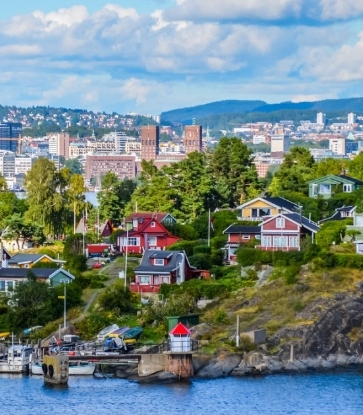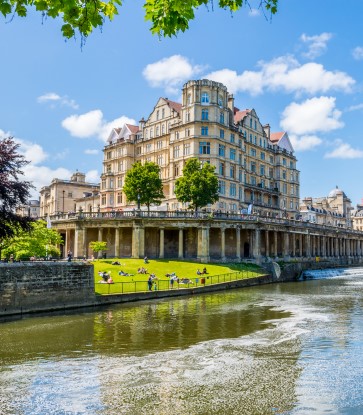Many of us do our part to reduce our carbon output in the kitchen by having a compost bin next to the trash can or swapping poultry for red meat in the fridge. These actions are crucial when you consider that food—from the way it is grown and transported to how it is disposed of—accounts for about one third of global emissions.
However, there's potential for a much bigger impact when restaurants make these sustainable choices. "Restaurants in most countries represent the largest part of the food system economically, larger than farming and retail," says Anthony Myint, restaurateur and co-founder of ZeroFoodprint (ZFP). For Myint, this means restaurants also have the largest responsibility to reduce their carbon output and fight climate change.
The founding of ZFP in 2013 was the result of a study comparing the greenhouse gas emissions (CO2e) of restaurant meals versus home cooking. The findings revealed that restaurant dining is not as carbon-intensive as is often assumed. The average home meal produces about 8 kg of CO2e while the average restaurant meal produces 8.7 kg of CO2e.
"The study confirmed that restaurants are not necessarily wasteful or bad for the environment, that restaurants could take the knowledge and make very impactful improvements and that, most importantly, restaurants could send a modest portion of proceeds towards environmental projects in the food system and reverse climate change," Myint explains. These three tenets are ZFP in a nutshell: the nonprofit assesses a restaurant's carbon output and provides guidance so they can reduce their "foodprint."
"Many great chefs and restaurateurs want to do the right thing, but we are all so overwhelmed with the nuances and challenges and finances of daily operations that doing the right thing needs to be very legible, very practical and very impactful," Myint says.
ZFP is slowly gaining traction thanks to a small but dedicated operations team. Its roster of restaurants has grown to nearly 20, spanning the U.S., Denmark, Portugal and Hong Kong. "The ZFP restaurants are early adopters banding together to create a critical mass of recognition," Myint says.

Three-Michelin-starred Benu in San Francisco was the first restaurant to sign on after study subject Noma in Copenhagen and Myint's Mission Chinese Food, also in San Francisco.
"As a chef, Corey Lee has been witnessing the effects of climate change on the seasons and availability of certain products. But having awareness about a problem is not the same thing as taking action or being held accountable," says Jasmine Peterlin, project director at Benu. "As restaurants, not everyone has the expertise or knowledge to tackle the issue on their own, and I think ZeroFoodprint can be a really helpful tool."
The first New York restaurant to join the initiative was Mettā in Brooklyn. For owner Henry Rich, it was a no brainer. "I was sold in the first few minutes," he says. "It's a baseline ethical requirement of working with food in 2018...There's no other option."
As a restaurant owner, he feels a sense of obligation to make sustainable choices. "We're making decisions that are hundreds of times more impactful because we're feeding hundreds of people. So, our decisions are multiplied," he says. "But more importantly, people learn a lot about food and food trends through restaurants and chefs. Things that happen in small restaurants can have massive ripple effects in the larger restaurant world and ultimately in grocery stores and people's homes."
Washington, D.C.'s first ZFP restaurant was Michelin-starred Bresca, but chef Ryan Ratino isn't looking for praise for his efforts. "We're not groundbreaking. We know we're not doing something revolutionary," he says. Ratino hopes his participation will start a conversation in the city and encourage more restaurants to sign on.
When a restaurant decides to join ZFP, its operations are assessed to determine its foodprint. "They analyzed all of our ingredient use and gave us a breakdown of what was contributing to our total carbon footprint," Peterlin explains. "They also looked at our energy use and connected us with The Food Service Technology Center to do an audit of our appliances and make suggestions to improve energy efficiency."

"They want to know everything," Ratino adds. "We had to read out electric meters, we had to look at water consumption." He was pleased with the results of his assessment, which came out to seven kilograms of CO2e—less than the average home-cooked meal.
This insight can motivate restaurants to scrutinize their practices. "When you're watched or being critiqued on that, it makes you try even harder," Ratino says. "We've always tried hard, but now we know where we can even improve more and more."
That's when the process of becoming carbon neutral begins. "Decreasing food waste and being more energy and resource efficient are obvious ways. Implementing composting is incredibly important," Myint says. "But for most restaurants, ingredients represent about 70% of the carbon footprint. So really, the most impactful choices [are] to be mindful [of] portion sizes and to de-emphasize grain-fed beef and lamb."
"Mission Chinese Food raised prices on red meat dishes by $1 to reflect environmental costs and uses those funds to make the restaurant carbon neutral," Myint explains. "Noma, for example, lowered [its] carbon footprint 30% by switching to renewable energy and also reorganized [its] foraging schedule to minimize miles driven."
Ratino found that in-demand cuts of meat and resource intensive vegetables like asparagus were disproportionately contributing to his carbon output at Bresca. Butter was also a huge factor. "Your butter consumption affects so much more than you would even think because dairy cows are full-grown animals that have feces and burps that then create carbon," he says. "We're a French kitchen. We use a lot of butter. That was one of our biggest impacts."
He opted to remove strip loin from the menu in favor of chicken, use only local asparagus during its short season, and swapped a portion of the kitchen's cow butter for goat butter.
Benu implemented simple logistical changes to help reduce its output. "Things like switching to LEDs, changing our sink spray nozzle, and adding motion detectors to our lights," Peterlin says. "Over time, those small tweaks can really make a difference."
As restaurants improve their practices, they can be re-assessed to determine their new foodprint.
In addition to these changes, restaurants can purchase carbon offsets to balance out their emissions. "We were able to offset the full carbon footprint of all of our restaurants to become carbon neutral," Peterlin says.
"By going carbon neutral we know that we're at least covered on that front," Rich adds. "We can lower waste more, we can find more sustainable farms, but we're at least covering our carbon cost."

While the ZFP restaurants are not in it for the money, Ratino says that sustainable choices can actually save a few bucks here and there. "It doesn't save you time, but it saves you money, and you serve better food," he says. Bresca now renders its own fat from various animal proteins, which means the restaurant saves money on buying some oils.
"We all know that restaurants have tight margins," he says. "I think that's something that helps pique the interest."
Restaurants that are part of ZFP also donate a few cents per diner to environmental initiatives. Myint explains that the cost is negligible when weighed against the benefits. "At Mission Chinese Food, if we gained a table each week, that would pretty much cover our contributions to environmental projects and make being carbon neutral a financial win," he says. "Our goal is to create the culture where one person in San Francisco will choose Mission each week because it's carbon neutral."
"You can also imagine a restaurant choosing to involve the customers in the process by simply charging a few cents as a pass through contribution, in which case, participation would cost the restaurant nothing," he adds.
Myint says the next step in the revolution is using the investments from the carbon neutral restaurants to pilot a soil carbon market—funding soil carbon credits to encourage farms to adopt better climate practices. "In other words, using a circular economy to create a renewable food system," he says.
Participating restaurants are already thinking about going carbon neutral with future projects. "Every restaurant that I do from here on out, I will try and belong to ZFP," Ratino says. He has plans to open Jônt, a restaurant that explores the notion of time in cooking, this spring.
Rich has lofty goals to take his carbon neutral restaurants a step further. "In 2019, I want the projects to be removing carbon from the atmosphere," he says.























